Farm tools of early times are one of the most prominent placeholders in today’s vintage market. Among these, hay rakes are probably the most talked about vintage farm tools. I realized this after coming across a beautiful antique hay rake during my last trip to the flea market.
Farming tools might not seem like the most lucrative or popular types of antiques for collectors – but don’t give into this thought. Any and all items work as antiques – so long as they have value, and a good history to pair with.
As a vintage enthusiast and a collector, I do not stop before I know everything there is to be aware of about the antique piece I have in my possession. This remains true even if I only think about having it – and that’s exactly how I determine its value.
I knew that the hay rake I was looking at was antique, rare, and would be a beautiful addition to my fancy vintage collection. I had to have it, so I bought it. That story didn’t end there. In fact, it was only the beginning. Right after I purchased that elegantly pretty antique hay rake, my struggle to find out everything about it and determine its value started.
In this article, I will share all that and let you know how you can identify an antique hay rake and determine its true value.
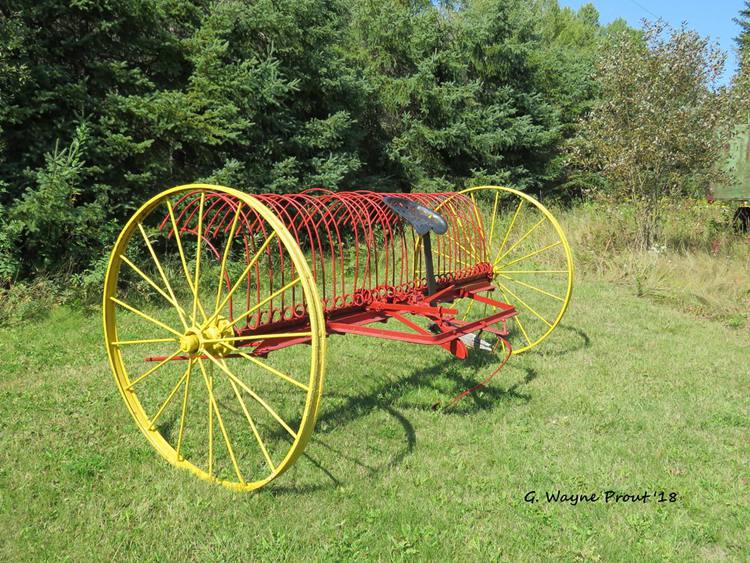
Table of Contents
Hay Rake: A Historical Overview
A hay rake is a tool that farmers use to rake hay into piles before picking it up manually. Hay rakes came in different forms and variations.
The earliest hay rake was a handheld one made of wood and metal. It was a long stick with wooden or metallic teeth attached at one end.
However, in later years, rakes were made so that they were pulled by horses, mules, or oxen. Much later, they also started being pulled by tractors.
Early Handheld Hay Rakes
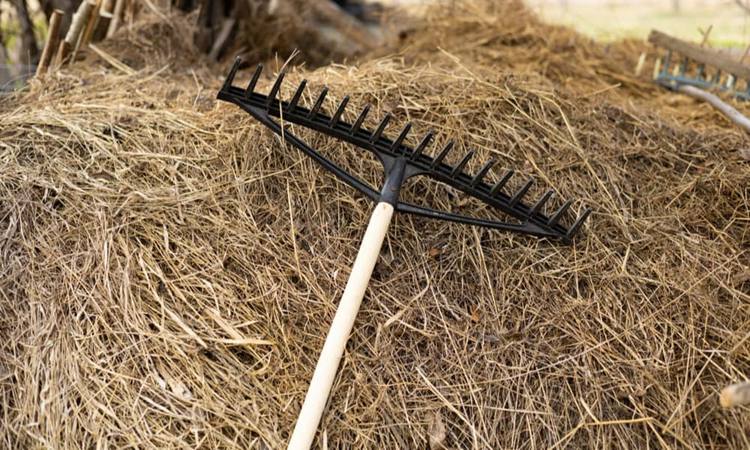
People used handheld hay rakes for centuries. They were, in fact, the most populous kind of hay rakes because not everyone could afford animals or a tractor to pull rakes.
The very first handled rakes were made out of tree branches. Due to their convenient abilities and durable qualities, handheld hay rakes started getting manufactured on an industrial scale.
The design was quite popular during the nineteenth century – A long wooden stick with a set of wide-spaced teeth attached at the bottom (made of wood and iron in later years). To use it, a person would drag the handheld hay rake over the dried grass, and the teeth would gather the hay into a pile.
However, using handheld hay rakes, one man could only collect hay from up to 2 acres per day, which was basically nothing compared to a horse-drawn hay rake. Eventually, handheld hay rakes went out of business.
Before being absent from farming tools, handheld rakes saw a lot of different variations and construction designs, even though they were subtle. These variations are quite fascinating to explore.
Horse-Drawn Hay Rakes
Horse-drawn hay rakes were wide two-wheeled machines with curved wood or iron teeth. They were operated by a farmer sitting on a seat mounted over a rake and pulled by a horse.
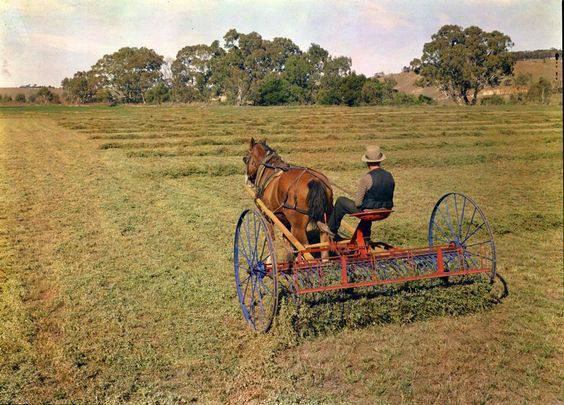
Tractor-Drawn Hay Rakes
Tractor-drawn hay rakes were very similar to horse-drawn hay rakes. The only difference was that instead of a horse, these hay rakes were pulled by a tractor. They were designed to make it possible for them to be attached to the back of the tractor.
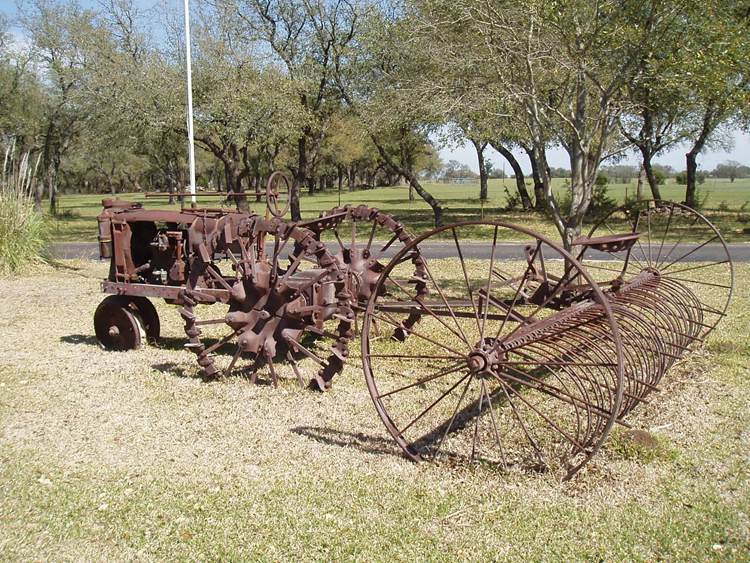
Identification of Antique Hay Rakes
You can find an old hay rake sitting and rusting on an abandoned farm, or you can find it being sold in an antique sale. Since most people feel there is no practical use for hay rakes today, they are pretty easy to come by.
That being said, not many people are interested in collecting antique farm tools. One reason is that they’re just not that excited about them. Another one can be their large size which might cause storage problems. You might make enough space to display a vintage handheld hay rake, but making room for a horse-drawn one can be difficult.
Usually, big ones (horse and tractor-drawn) are found sitting in museums and educational venues.
No matter where you find or buy it, you must know what you’re dealing with before bringing it home. We wouldn’t want to fill up your room with just an old, rusty piece of history, right?
So, here is how you can identify an antique hay rake and ensure that you have the real thing in front of you.
Parts and Materials of Antique Hay Rake
The first thing you should take a detailed look at is the parts of the hay rake. For handheld hay rakes, you know that the central stick was made of wood while the teeth were made of iron or steel.
However, handheld hay rakes are pretty easy to replicate. Since there has been no industrial production for many years, it is nearly impossible to determine if it is antique or not.
On the other hand, big and wheeled rakes are more valuable and worthwhile as antiques. The central part of these rakes was made from wood, and the wheels and teeth were produced with metal, usually steel or iron.
Hay rakes that were made in later years were entirely made from metal. By looking at the materials used, you can quickly identify if the hay rake was made in the early or late years.
That said, identifying hay rakes to the specific year is impossible, even by a professional. They can only provide you with the estimated manufacturing year, not the exact one. But you can do that by yourself too if you know what things to notice.
First, if a hay rake has a wooden tongue, it is likely a horse-drawn hay rake. That would make it older, but not significantly because horse-drawn and tractor-drawn hay rakes emerged around the same period, possibly in the 50s. And they had the exact same parts and functions associated; the only difference was a wooden tongue.
Secondly, see if the rake has 3 bars with the teeth or 4. Three-bar rakes were older than four-bar rakes – making a significant difference.
Third, hay rakes with rubber tires on the back did not come out till the late 50s. So, rubber tires on the back would make the rake of later years.
Manufacturers of Antique Hay Rakes
As mentioned above, there was no industrial production of hay rakes in the beginning and not even much in the later years. One person made something, and others just replicated it. There were no companies or manufacturers that sold these things. Blacksmiths, carpenters, and farmers themselves made the best products possible.
Therefore, it is essential to keep track of when a certain kind of hay rake was invented and when it became obscure.
Initially, farmers just used wood to make the whole handheld hay rake. When iron and steel got involved, blacksmiths and carpenters were trusted with the job.
Through the repetitive process of trial and error, farmers saw the finished products that made their job easy. That is why we can see numerous designs of hay rakes from that period.
It wasn’t much later when wheeled hay rakes started being invented. In the 1850s, manufacturers began adding seats to the hay rakes. In 1849, inventor Calvin Delano from Maine patented a sulky hay rake with wooden-iron teeth that a farmer could raise with a lever without leaving a seat.
In the 1870s, the horse-drawn hay dump rake was invented. Around the 1890s, the first rake that could pile hay into squares emerged on the market. But since this machine couldn’t move, farmers brought the hay by hand.
Most of these machines mainly were entirely made of wood. When they became rotten, they ended up as firewood. There was no way to preserve them. Consequently, they are scarce now. As a collector, you need to be extremely patient if you want to find one in decent condition.
If you find one, look at its parts, make and materials, and type. That would tell you when it was made. Since there are no manufacturer’s marks on these things, this is the only way to know.
One prominent name in hay rakes was John Deere. Born in Rutland, Vermont, in 1804, Deere was a blacksmith who served as the toolmaker and a repairman in the village. Tools were just a start. John Deere went on and pioneered different kinds of machinery that made farmers’ lives easier and gained him some recognition.
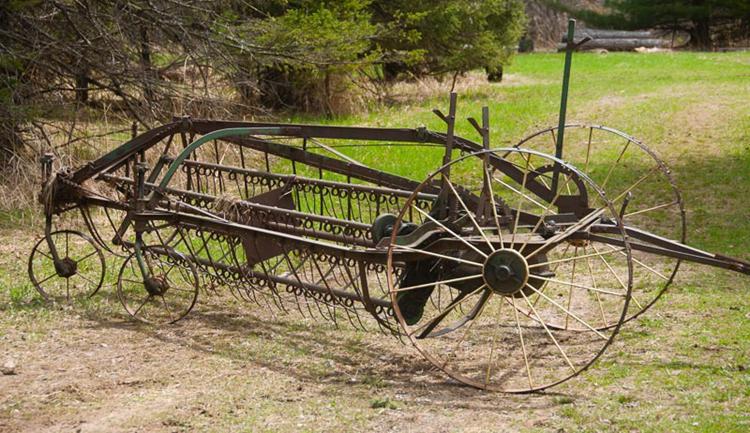
Traditionally, Deere made machines and tools only when someone ordered them. This business style was slow, so Deere increased production and put them up for sale. His products were a hit.
Deere opened multiple companies throughout his early years of success with different business partners. The company that was officially named after him was Deere & Company, which opened in 1868.
In the 1800s and 1900s, John Deere’s hay rakes were one of the most sought-after products in agriculture, and his name is still being used to hype up antique farming tools. The company is still in existence and is known globally.
Antique Hay Rake Value Guide
Whether buying, selling, or just exploring an antique hay rake, it’s critical to know its worth. Some people don’t realize they are sitting on a fortune because a perfect antique piece of hay rake can make you some good dough.
Antique handheld hay rakes are sold around $100 to $600, or even $1,000, depending on the condition, quality, and restoration. Suppose the handheld hay rake is exceptionally old, rare, and preserved with exciting elements. In that case, it can sell even more in an auction.
A good thing about handheld hay rakes is that you can find them in complete units and elegantly put them on display in your garden. On the other hand, it’s more common to find just parts of horse-drawn and tractor-drawn hay rakes than complete units.
Usually, the wooden part of the rake will have rotten away, and only the iron or steel parts would be there as antiques.
It is hard, not impossible, to find a hay rake that has all its parts intact, but its condition would be so poor that it wouldn’t sell for much money. However, if it is in a nice-to-display condition, it can be worth more. A complete, good-condition piece can even sell for multiple thousand dollars.
The final price always depends on three factors:
Age: The age of an antique hay rake is probably the most critical factor in determining its value. The older it gets, the more valuable it is. However, since there is no definite way to determine the exact age of the hay rake – its parts, materials, and designs are all we have left with to figure out the estimated manufacturing year. It will be valued on that basis.
Condition: Condition goes hand in hand with age. The older it is, the poorer its state will be and the lower the price. It’s a complication, really. A perfect blend is made when a piece is considerably old and still in good condition; that’s the kind of piece that can sell for thousands of dollars.
Kind and Design: The kind of hay rake significantly affects its value. Handheld hay rakes will be valued entirely differently than tractor-drawn and horse-drawn hay rakes. But even these major categories are further divided into different types.
For instance, on eBay, an antique 1800 American Wood Cranberry Wood Rake is being sold for $100, whereas a large antique Agrarian Hay Rake Art Piece is on sale for $2,500.
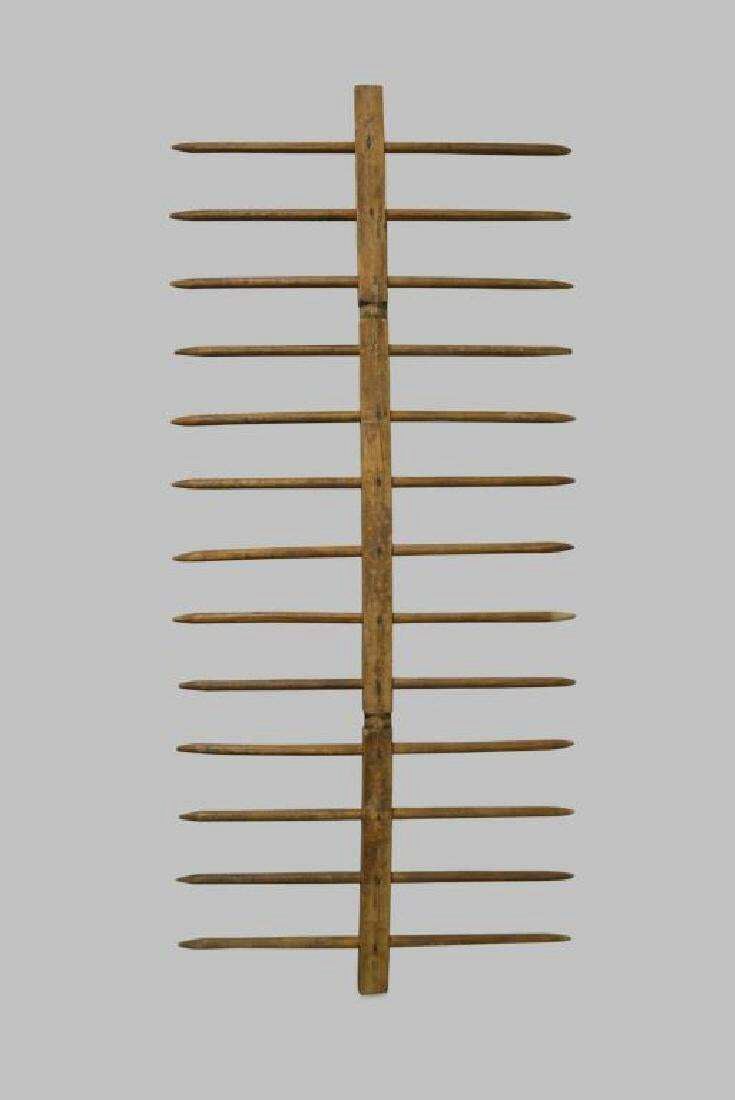
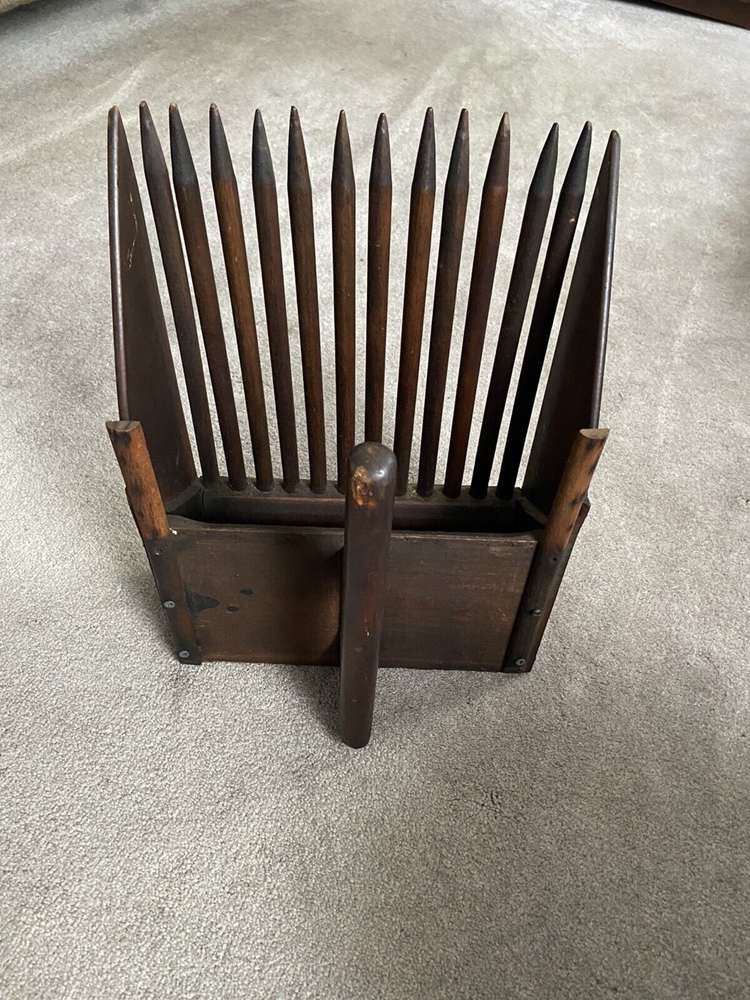
Both of the rakes above are handheld, but they are still worth more than this antique John Deere 594 Hay Rake, which tells us that handheld rakes are not always cheaper than horse-drawn ones.
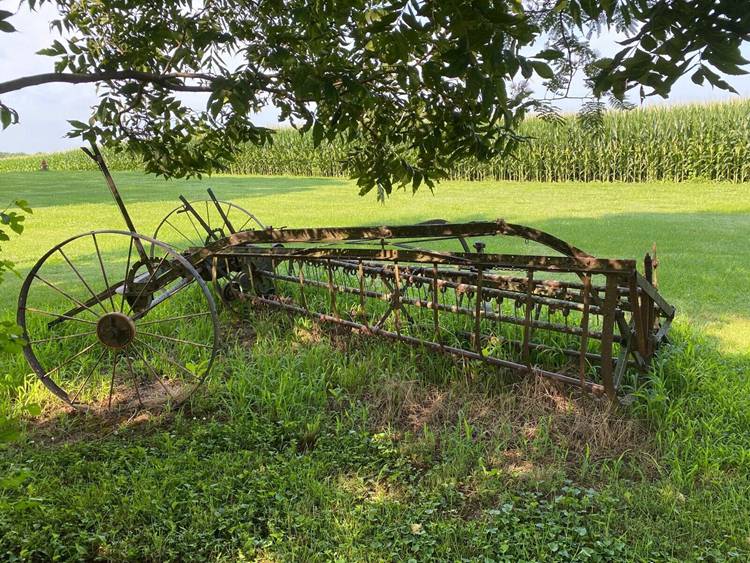
Things to Mind When Buying An Antique Hay Rake
When you have researched and are looking to buy an antique hay rake to add to your vintage collection, be careful of a few things.
First, mind the demand and supply. Just because the item is very antique doesn’t mean it’s scarce. If you even doubt the hay rake’s overpriced, you can skip it and explore the market more.
In fact, there are hundreds of listings of antique hay rakes on eBay, and some of them have been there for more than a year.
Second, antiques have no definite price. Sometimes, the condition doesn’t matter when the hay rake is exceptionally antique. The price is what the owner puts on a tag. But that doesn’t mean you have to pay that price. You can create a new price by putting forward your own offer. In antiques, the price is always what the buyer is willing to pay.
Some of the antique hay rakes in the market have been there for the long haul, which means there is a big difference between the demanded price and buyers’ offers. You can swoop in and find a way in the middle since there’s a lot of bargaining room.
Conclusion
Hay rakes are one of the most prominent antiques regarding vintage farming tools. Back in the day, hay rakes were used to cut hay into piles and prepare it to be loaded into a wagon or carried across the farm. The hay had to fluff up and turn so it would dry, and the hay rake made the entire process easier for the farmers.
The teeth of the rake were dragged around the ground and cut the hay. When the teeth were full, the farmer would lift the rake and put it aside as a pile.
The earliest kinds of hay rakes were handheld. Throughout the centuries, different variations of handheld hay rakes were manufactured and spread across the farmlands of America. Handheld hay rakes only stopped being used when horse-drawn and tractor-drawn hay rakes were invented.
Apart from these categories, hay rakes varied in materials, designs, and artistic styles.
Antique markets can see all kinds of vintage hay rakes being sold. If you have a large property and an interest in antiques, a vintage hay rake can make a perfect display piece in your garden.
A piece would look beautiful sitting if it is in considerably good condition. If it is not, you can restore it and decorate it as you want. But remember that restored and repaired hay rakes wouldn’t have the same resale value.
In all cases, an antique hay rake with an appealing vintage design can give a perfect nostalgic theme to your garden.






![Vintage Schwinn Bikes: [Types, Identification, and Values]](https://www.txantiquemall.com/wp-content/uploads/2022/05/5.-Schwinn-1967-Ramshorn-Fastback-Stingray-Sky-Blue-vtg-600x450.jpg)
